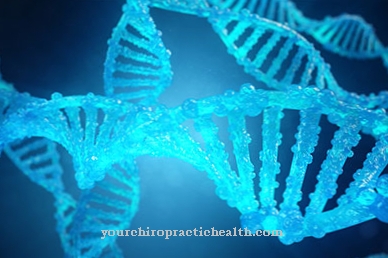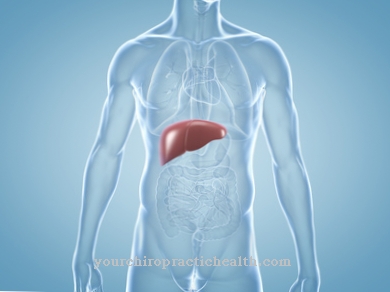Inflammation of the hair roots are very uncomfortable but common inflammations of the hair follicles. Small knots of pus form around the hair at the roots of the hair.
What is hair root inflammation?

A hair root inflammation describes an inflammation of one or more hair follicles. The hair roots are surrounded by hair follicles all over the body. These are responsible for anchoring the hair in the skin. Only the soles of the feet and the palms of the hands are hairless.
Therefore, folliculitis can develop all over the body. Frequently affected parts of the body are the scalp, beard hair, chest hair and leg hair. The inflammation causes whitish-yellow pus pustules to form. The affected areas are often painful or itchy. Depending on the severity of the inflammation, a visit to a doctor is useful.
causes
Inflammation of the hair roots occurs, for example, from wet shaving, as it can damage the hair follicles. In women, the legs and armpits are often affected, in men the beard area. The intimate area is also vulnerable. Minimal injuries can cause germs to penetrate the skin and multiply there. Regardless of the shave, folliculitis can also develop on the scalp and on the male chest.
Inflammation of the hair roots is a bacterial infection. The bacterium Staphylococcus aureus is usually responsible for this type of inflammation. This is part of the physiological human skin flora and is therefore ubiquitous. If the bacterium is able to penetrate the body through injury, inflammation occurs. Stapylococcus aureus finds suitable living conditions in the body. These are aggravated by warm, humid conditions such as those that occur when sweating.
This puts all types of skin folds at risk. A weak immune system can also contribute to the development of hair root inflammation. Chronic hair root inflammation is common as a result of diabetes. A weakened immune system increases the risk of inflammation. Oily care products also clog the sebum glands that end in the hair follicles. This means that toxins can no longer be released to the outside world. In some cases, this can lead to inflammation of the affected tissue.
Symptoms, ailments & signs
A hair root inflammation is a small knot that is pierced in the middle of a hair. Often such pustules are filled with greenish-yellow pus. The affected area is usually very itchy. In some cases, inflammation of the roots of the hair can be painful.
They are often a purely cosmetic problem and do not cause any discomfort. A typical symptom is a clearly visible reddening of the skin. The focus of inflammation is severely swollen in many cases. In the case of untreated hair root inflammation, such knots can also occur over a larger area. An abscess can develop.
The pustules are typically about the size of a pinhead. However, if the inflammation spreads deeper, it can grow into a boil or even a carbuncle that can be the size of a walnut. As a rule, hair root inflammation only occurs on parts of the body that have hair follicles.
This is especially the case on the buttocks, on the chest, on the face, on the chin or neck area, on the scalp, in the genital area, on the arms, on the legs and on the thighs. In most cases, inflammation of the roots of the hair will heal on its own. Scarring and hair loss rarely occur.
Diagnosis & course
The diagnosis of hair root inflammation is made by examining the affected area for characteristic features.
These include swelling and redness around the hair follicle and pus that are the size of a pinhead. Usually, patients complain of itching. In principle, inflammation of the roots of the hair is harmless and heals easily under the appropriate conditions.
Inflammation at the hair root usually affects several follicles and can spread over a large area. If the inflammation occurs again and again, the attending physician will carry out a detailed examination. In this case, inflammation of the roots of the hair can be an accompanying symptom of other diseases. This includes, for example, diabetes mellitus.
Complications
The hair root inflammation leads to the formation of pus knots on the hair. These knots in the hair can also spread to the beard, causing so-called beard lichen. There will still be severe redness and swelling, which can lead to pain. The aesthetics of the patient is also greatly reduced by the inflammation of the hair roots, so that many sufferers are ashamed of the symptoms and suffer from inferiority complexes.
The scalp also becomes itchy. In most cases, this condition does not lead to particular complications. It can be restricted and combated relatively well with the help of adequate hygiene. In most cases, medical treatment is only necessary if the hair root inflammation recurs in the patient and cannot be fully combated.
Medicines are used that inhibit inflammation and thus alleviate the symptoms. There are no further complications. However, it may be necessary to shave off the hair to completely remove the inflammation of the hair roots. This inflammation does not limit or reduce life expectancy. However, it cannot be predicted whether the disease will recur in the patient later in life.
When should you go to the doctor?
Inflammation of the hair roots should always be treated by a doctor. As a rule, there is no self-healing. If the hair root inflammation is left untreated, it can lead to hair loss. At this point at the latest, a doctor should be consulted.
However, it makes sense to see a doctor if pustules develop on the hair roots. Small pus nodules can also develop and be associated with pain. Furuncles on the scalp also indicate a hair root inflammation and must be examined by a doctor.
The inflammation can spread from the scalp hair into the beard and cause the same discomfort there. First and foremost, a dermatologist or general practitioner should be consulted in the case of hair root inflammation. Either doctor can treat this inflammation. There are no particular complications and the disease always progresses positively if the inflammation is treated correctly.
Doctors & therapists in your area
Treatment & Therapy
Treatment of inflammation of the roots of the hair is rarely necessary. However, in chronic or severe cases, a dermatologist should be consulted. He will resort to an antiseptic to disinfect and an antibiotic ointment to be applied to the inflamed area. The doctor only prescribes oral antibiotics if the inflammation is very advanced. These reduce the inflammation from within and kill the bacteria.
If the cause of the hair follicle inflammation lies in the wet shave, it is advisable not to shave - at least until the inflammation has subsided. This applies to the legs and armpits of the woman as well as the beard hair of the man. When dry shaving, it is important to pay attention to hygiene. In particular, this includes cleaning the razor after each use. Ideally, the razor should be disinfected after each use.
If the hair follicles become inflamed, it is important to use the right personal care products. Natural and non-irritating substances are the first choice. Products containing tea tree oil are recommended. Tea tree oil cares for the skin in a gentle way, has an antibacterial effect and does not clog the sebum glands. In acute cases, it is helpful to dab the oil directly on the affected area.
Outlook & forecast
Inflammation of the hair roots has a good prognosis. In most cases, no medical care is required from the patient. The use of other healing methods or therapies is also not necessary. In the case of inflammation of the hair roots, spontaneous healing occurs within a few days.
Consequences or diseases are not to be expected in most cases of hair root inflammation. The inflamed areas of the body heal within a few hours after they develop. Freedom from symptoms is normally achieved within three days at the latest.
Despite the good prospects for healing, hair root inflammation can develop again in the course of life. If the causes of the inflammation are not found and prevented, a new development of the symptoms is possible at any time. The return of symptoms does not change the good prognosis. The person affected can also count on a good chance of recovery if the hair roots become infected again.
A deterioration in health occurs only in very rare cases. As soon as other pathogens penetrate the inside of the body due to the inflammation or open wounds form, the prognosis changes. The germs, viruses or bacteria increase the risk of developing blood poisoning. This can lead to a life-threatening condition for the patient. Only quick and good medical care can relieve the symptoms.
prevention
There are various measures to prevent inflammation of the hair follicles. Healthy hygiene and personal hygiene are the first step in preventing folliculitis. Suitable razors and their meticulous cleaning after use are essential. Care products that clog the pores should be avoided. After shaving, only products should be used that are neither inflammatory nor highly stressful or irritating.
With a wet shave, cleaning and disinfecting the blades is just as important as with a dry shave. Blunt razor blades represent another danger pole. These pull on the hair when you shave and thus lead to small injuries, which again allow bacteria to enter.
Measures to strengthen the immune system are useful for prevention. This includes, for example, a healthy diet and the cessation of alcohol and cigarette consumption.
Aftercare
In the case of inflammation of the hair roots, there are a few options for follow-up care available to those affected, but primarily the disease should be treated itself so that no further complications or complaints arise. The earlier this inflammation is recognized and treated by a doctor, the better the further course of this disease will usually be.
The person concerned should therefore contact a doctor as soon as the first symptoms and signs of the disease appear to prevent further deterioration. The treatment itself takes place through the use of various creams and other care products that are intended to alleviate the symptoms. The person concerned should always make sure that it is used correctly with the prescribed dosage.
A doctor should always be contacted if you have any questions or if anything is unclear. It should also be noted that the hair must be dried completely after washing so that the hair root inflammation cannot spread any further. In many cases, tea tree oil can also alleviate the symptoms and accelerate healing. Likewise, high standards of hygiene must be observed to prevent renewed hair root inflammation. This disease does not usually have a negative impact on the life expectancy of the person affected.
You can do that yourself
Hair root inflammation is often caused by using the wrong shaving technique. This can be corrected quickly in everyday life with simple steps and little effort. The direction of shaving and the pressure exerted on the skin must be optimized. When shaving, hectic rush is to be avoided. The razor blades must always be kept clean and should be replaced regularly. Changing the razor or method of shaving can help reduce discomfort.
In addition, the use of care products before and after shaving must be adapted to the needs of the skin. In the case of hair root inflammation, it is important that there are no open wounds, as germs can enter the organism through these. Small swellings often appear on the skin that are filled with pus fluid. With the use of sterile materials, each affected person can remove the fluid himself by gently squeezing the affected areas of the skin.
If the hair root inflammation occurs increasingly on the head, the use of combs or brushes should be checked and optimized if possible. Frequent scratching of the head should be avoided. The use of hair care products should also be checked. People who tend to have flaky or dry skin in particular need moisturizing care. Oily skin, on the other hand, should be supplied with degreasing products.





.jpg)







.jpg)

.jpg)
.jpg)











.jpg)